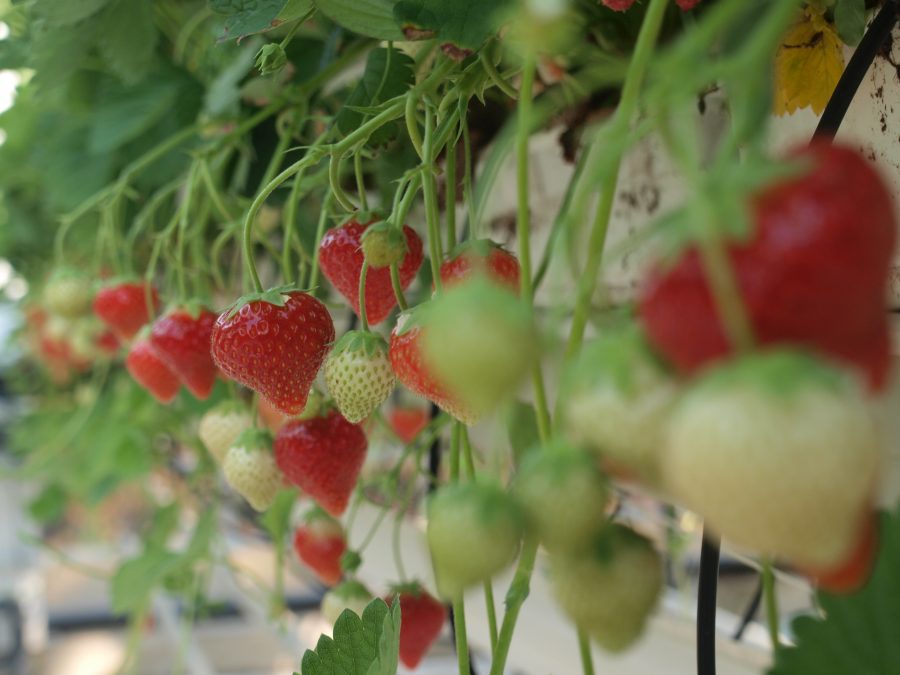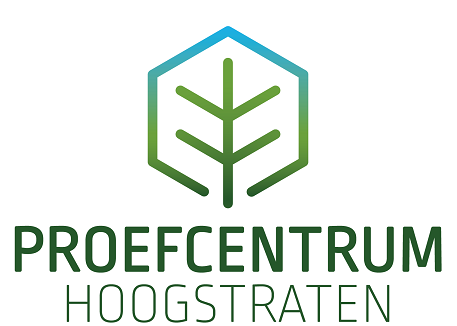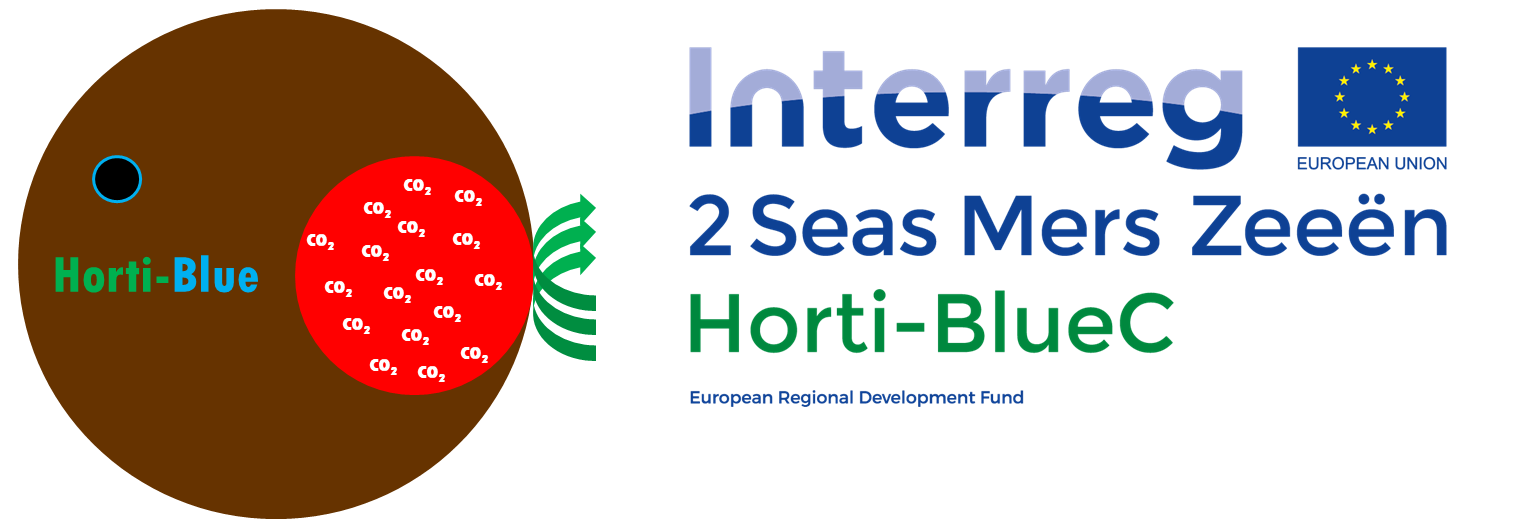Press release | Project news Growing substrates with renewable resources match performance of classic, less sustainable relatives.
Greenhouse cultivation can be more climate-friendly by reducing use of peat or rock wool.
Comparative greenhouse research on tomato and strawberry shows that yield remains the same even when rockwool and a large part of the peat, respectively, are removed from the growing substrate, and replace the ingredient with renewable or less-energy-intensive products such as CHITIN, BIOCHAR AND GREEN COMPOST. The Horti-BlueC researchers are excited to publish this promising result.
The horticultural and potting soil sectors have known for some time that peat and rock wool - two important ingredients of their cultivation substrate - carry a heavy environmental and climate burden. The scientific search for workable, competitive substrate recipes with more sustainable properties is now successful.

Less peat? Rockwool or coconut as a subsitute then?
Peat has been mined for centuries, formerly as a fuel, today also as a main ingredient of potting soil. But peatlands are important as carbon buffers in the fight against climate change. Peat contains (just like the other fossil materials like oil or coal) a lot of organic carbon, which is released into the atmosphere in massive amounts as CO2 through oxidation. Because of the negative impact of peat mining and the ecological value of peatlands, peat mining is being restricted in more and more countries. Belgium does not extract peat but imports approximately 800,000 m3 per year, mainly from the Baltic States. Because of the sustainability argument, the demand for peat-free or peat-poor potting soil is becoming louder and louder.
Finding good alternatives for use in the "classic" peat potting soil or rock wool substrates is not obvious. Peat is a very stable substrate with optimal cultivation properties. Mineral substrates or raw materials such as coconut fibers, do possess similar properties, but they also 'sin' against sustainability principles. For example, coconut fibers must be transported over long distances and the production of these fibers also has a significant environmental impact.
Rockwool (mineral substrate) is a second raw material in growing substrates that is under pressure. Rockwool is created mechanically, by pulling rocks into fibers at very high temperatures. It is a production process that requires a lot of (fossil) energy. After the growing season in the greenhouse, stone wool mats are not reusable. Usually they are processed back as waste after less than 1 year. Their disposal (expensive for the greenhouse grower) and processing (into material such as pavers) is again high-energy. So stone wool also has a high ecological footprint. Stone wool slabs are now often used in applications like greenhouse cultivation of tomatoes and peppers. The demand for workable alternatives is growing here too.
Growing global market demand, an opportunity in terms of sustainability?
There are signs that the demand for cultivation substrates continues to grow worldwide, for a variety of reasons: Water efficiency for the same amount of fruit is higher when using a good cultivation substrate. Growers can avoid any plant diseases in a more controlled way. In the planting phase of greenery or trees in disturbed urban soils, substrates make the difference between success or failure. Already today, planting material for outdoor crops is increasingly grown first in a greenhouse potting soil to avoid the challenges of extreme weather conditions during germination, as well as to shorten the growing season. There is the phenomenon of innovative, climate-cooling systems such as green roofs, roof gardens, green walls, but also roof greenhouses and vertical crops, all of which require excellent substrates to grow plants in an urbanized environment.
This increasing demand may create tension on the supply (quantity and quality) of the current raw materials. In the event of such market tensions, the cost price of said materials may rise.
Bart Vandecasteele (ILVO): "There are opportunities from the predicted growth, especially if you use sustainable raw materials. The challenge is to get the potting compost mixtures of the future sufficiently technically sound and well balanced, as well as sustainable. That also means renewable and preferably local raw materials."
Experiments around circular, dual-use building blocks for crop substrates
The partners of the European Horti-BlueC project conducted experiments for strawberry and tomato cultivation at various locations and on a practical scale. In their new substrate compositions, they tested the power of green compost, plant fibers, biochar and chitin, among other things. The sustainable mixtures were examined in terms of their effects on growth and health of strawberry and tomato, as well as their interaction with fertilization. All trial mixtures were produced by the Belgian company Agaris.
For tomato, the 100% replacement of rock wool by a peat-free and organic mixture with 40 vol% coconut fiber, 30 vol% wood fiber, 20 vol% bark and 10 vol% green compost was chosen. For strawberry, 40% of the peat fraction was removed (to begin with) from the conventional mixture. In its place was 25% wood fiber and 15% green compost.
Julie Moelants (PCH): "The results are very clear: All of the new mixtures scored similarly to conventional rockwool, or the mainly peat-containing traditional potting soil. In trials at our facility, the new alternative substrates also proved to serve the full growing season."
Biochar en chitine, new kids in town for potting soil?
Biochar is a very stable form of carbon that can be used as a bulk material in cultivation substrate. Biochar is created as a residual product when plant materials are converted using the technique of pyrolysis: a chemical process at high temperatures of 400 to 700°C and low oxygen conditions, which means no combustion takes place. This yields a black solid, similar to charcoal. The biochars in the tests were produced by the Dutch ECN-TNO, based on wood, plant fibers such as flax straw and used cultivation substrates. In the production of biochar, both the heat released and the CO2 in the greenhouses can be used to replace pure CO2 fertilization and fossil fuel heating. The greenhouse trials showed that, compared to the classic reference substrates, cultivation substrates with biochar scored at least as well in terms of yield, both for strawberry and tomato.
Chitin is found in crustacean byproducts and is usually mined chemically. Within the Horti-BlueC project, it was shown that 2 streams could be useful as chitin sources: the shells of the North Sea shrimp (Cragnon Cragnon), the byproduct of mechanical peeling, and the shells of the Chinese woolly crab (Eriocheir sinensis), an invasive species in our ports and waters. Chitin mixed in as a substrate additive has a positive influence on the microbial community around plant roots in the soil. When used in low doses, chitin appears to improve plant resistance to disease. But chitin can also release mineral nitrogen and thus replace artificial fertilizers.
Reuse of substrates, asset for climate mitigation
Bart Vandecasteele (soil and substrate specialist, ILVO): "Our results show that it is perfectly possible to give the (carbon in) crop substrates a second life. I see three possibilities: by reusing them directly, by putting them into a composting facility as brown streams, or by using them as raw material for biochar. Direct reuse of potting soil-with-peat fraction is a valuable option, provided a sustainable decontamination technique is used."
This is the link to climate mitigation: Cultivation substrates based on organic materials such as peat, wood fiber or biochar contain a lot of carbon. That carbon is very stable, meaning that the potting soil breaks down slowly and the carbon is released back as CO2 very slowly. Less than 1% of the carbon breaks down annually. If one incorporates used potting soil into an agricultural soil or composts it, then the present carbon remains for a very long time as stable carbon and you obtain more carbon storage in the soil.
Reuse is easy if it happens at one private (horticulture) company, but currently it is still complex when the flows move between several companies, because of the waste regulations. Sufficient attention must be paid to the control of possible pests and diseases during reuse, e.g. by disinfection or use in complementary crops.
Circular reuse as a business model
The technical feasibility of processing used crop substrates by composting has been demonstrated before, and is already operational in Flanders. The experimental Horti-BlueC growing substrates have also shown themselves to be suitable for conversion into biochar. This allows you to reuse the nutrients and fix the carbon for a long time. At the end of the cascade, the used new cultivation substrates based on local and renewable materials can be used as soil improvers, so that we can store more carbon in agricultural soils.
This carbon storage in soils will potentially lead to additional income for growers in the future, as this important sequestration of carbon will be able to be financially supported as compensation for CO2 emissions from other activities in our society. If these substrates also contain very stable carbon in the form of biochar, the long-term storage of carbon will be even better assured, and so potting soil with biochar also has an additional added value here.
Policy conclusions
The new substrate mixtures can achieve the same yields as the currently commonly used materials.
Peter Melis (PCH): "There are circular alternatives, which can replace rock wool and at least part of peat and do so without qualitative or quantitative loss of tomatoes or strawberries. We will now use the results to convince growers to test and evaluate these new and more sustainable alternatives themselves."
This research can help policymakers and the industry to weigh up to what extent, how and when to make cultivation substrates more sustainable.
Ludwig Caluwé (Province of Antwerp, Provincial Executive for agriculture) and Leentje Grillaert (Province of East Flanders, Provincial Executive for agriculture): "We also underscore the importance of these results. It is possible to produce high-quality cultivation substrates more sustainably, away from peat and rock wool, and then to reuse them again and again in a circular cycle. There are many sustainability gains to be made here. We see a feasibility in the fairly short term. These results could provide momentum, as policy, growers and consumers alike become increasingly aware of the negative impact of peat extraction and of certain crop substrates."
Hilde Crevits (Flemish Minister of Agriculture): "A sustainable future for our agriculture is a future where we use water, nutrients and other natural resources efficiently. In substrate cultivation, optimization is, among other things, about reducing the use of peat, a raw material that is widely used today. The sector is certainly open to this. Now that research has produced feasible, more sustainable recipes, in the form of potting soils made from wood fibre, chitin, biochar or green compost, a gradual transition and a well-managed build-up of professional knowledge about the new products is called for. Flanders is supporting that transition through the Flemish Bioeconomy Policy Plan and the Flemish Action Plan for Food Loss and Biomass Waste Streams Circular 2021-2025."
International experts in cultivation substrates come to Flanders
From 23 to 26 August 2021 ILVO, Proefcentrum voor Sierteelt (PCS), Provinciaal Proefcentrum voor de Groenteteelt Oost-Vlaanderen (PCG), Proefcentrum Hoogstraten (PCH), UGent and UHasselt organized the international symposium 'ISHS International Symposium on Growing Media, Soilless Cultivation, and Compost Utilization in Horticulture'. This symposium will bring together new knowledge on sustainable growing substrates and discuss policies on peat replacement in horticulture in various countries.
Horti-BlueC is an Interreg 2 Seas project in which ILVO and PCH have collaborated with a team including 6 scientific and industrial partners on both sides of the English Channel. Horti-BlueC was funded by the Interreg 2 Seas program 2014-2020 (European Regional Development Fund, contract No 2S03-046) and the Provinces of Antwerp and East Flanders. The project is a partnership between ILVO, PCH, Agaris, ECN-TNO, Université de Lille, NIAB-EMR, ADAS RSK., and University of Portsmouth.
 |



